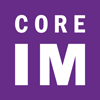Core IM
With the recent publication of new clinical trials in the management of heart failure, practice guidelines are rapidly changing. Although beta-blockers and MRA were already well established in reducing morbidity and mortality, newer studies have shown that ARNI are superior to ACE inhibitors (PARADIGM 2014, PIONEER-HF 2019). SGLT2 inhibitors have also proven to decrease heart failure hospitalization and cardiovascular deaths (DAPA-HF 2019, EMPEROR-Reduced 2020). This has led to the publication of the 2022 AHA/ACC/HFSA Guideline for the Management of Heart Failure. Join the Core IM team as they explore the importance for learners to be updated with the most recent guideline-directed medical therapy recommendations for heart failure.
First, listen to the podcast. After listening, ACP members can take the CME/MOC quiz for free.
CME/MOC:
Up to 0.5
AMA PRA Category 1 Credits ™ and MOC Points
Expires May 12, 2025
active
Cost:
Free to Members
Format:
Podcasts and Audio Content
Product:
Core IM
Welcome to Core IM, a virtual medical community! Core IM strives to empower its colleagues of all levels and backgrounds with clinically applicable information as well as inspire curiosity and critical thinking. Core IM promotes its mission through podcasts and other multimodal dialogues. ACP has teamed up with Core IM to offer continuing medical education, available exclusively to ACP members by completing the CME/MOC quiz.

Pearl 1: Beta Blockers
- Pathophysiology:
- Many proposed mechanisms of action, however, the exact mechanism is unclear. Overall, thought to reverse deleterious neurohormonal effects of the sympathetic nervous system.
- Outcomes and trial data:
- Most trials were done over 20 years ago.
- COMET Trial: The only trial that compared two beta blockers against each other.
- Carvedilol extends survival compared to metoprolol tartrate.
- The study was criticized for significantly under dosing metoprolol and using the short acting formulation (tartrate) instead of long acting (succinate)/
- The benefit of beta blockers appears to be a class effect.
- A meta-analysis showed a significant reduction in mortality with use of beta-blocker compared to placebo.
- While all beta blockers showed reduction in mortality, the largest mortality reduction was seen with carvedilol, although this was not statistically significant when compared to other beta blockers.
- Beta blockers increased EF by a mean of 4.1%.
- Beta blockade appears to be the most effective therapy for survival in patients with HFrEF (not acutely decompensated).
- There is a 14% increase in all-cause mortality for every 10 bpm increase in HR above 80.
- Resting HR > 80 bpm can cause myocardial dysfunction.
- Patient counselling
- Patients may experience lower blood pressure and heart rate, which is to be expected. However, they should inform their doctor if feeling lightheaded.
- Pro tips in initiating
- Controversy exists as to the optimal selection of a particular beta blocker.
- Carvedilol is non-selective and acts on beta 1, beta 2 and alpha 1 thus it has afterload reduction properties.
- Carvedilol can also improve insulin sensitivity
- Metoprolol acts only on beta 1 receptors and may be a better option if hypotension is a concern.
- Carvedilol is non-selective and acts on beta 1, beta 2 and alpha 1 thus it has afterload reduction properties.
- Few studies have answered the question of tolerability of beta blockers in heart failure
- Avoid starting in acutely decompensated patients with evidence of poor perfusion and volume overload.
- Controversy exists as to the optimal selection of a particular beta blocker.
Pearl 2: ACE Inhibitors, ARBs and ARNIs
- Pathophysiology
- RAAS activation leads to systemic vasoconstriction, sodium retention, left ventricular remodeling and oxidative stress.
- ACEI and ARBs act on different parts of the RAAS system but ultimately lead to inhibition of deleterious effects of aldosterone (vasoconstriction, inflammation, fibrosis, and arrythmogenesis).
- ARNIs are newer combination pills composed of sacubitril (neprilysin inhibitor) and valsartan (ARB).
- Sacubitril prevents the breakdown of natriuretic peptides (BNP, bradykinin, and adrenomedullin) leading to vasodilation, natriuresis, and decreased sympathetic tone.
- Sacubitril also leads to increased levels of angiotensin which is why valsartan is added.
- Outcomes and trial data
- Earliest evidence for ACEI includes the CONSENSUS and SOLVD trials. ARBs are thought to have a similar effect as shown in CHARM-Alternative.
- PARADIGM HF Trial: treatment with ARNI reduces cardiovascular mortality, HF hospitalizations, and all-cause mortality when compared to enalapril. NNT was 21.
- PIONEER HF Trial: sacubitril-valsartan is safe to initiate in patients with acute decompensated HF.
- ARNI therapy decreased NT-proBNP concentration compared to enalapril at 4 and 8 weeks without significantly different rates of medication related adverse events.
- Patient Counselling
- Most common side effects of ARNIs are hypotension and lightheadedness. Patients should monitor BP and inform their physician if BP <90/60 or if they are symptomatic.
- Pro-tips in Initiating
- Guidelines now support de-novo initiation of ARNIs, meaning that a patient does not need to be trialed on an ACEI or ARB before starting ARNI
- Is the patient already on an ACEI?
- There must be a 36-hour washout period required before prescribing ARNI if patient currently on ACEI
- Higher rates of hypotension observed with ARNIs compared to ACEI/ARBs. Diuretic dose or other BP lowering medications may need to be lowered.
- ARNI contraindicated in patients with prior history of angioedema related to previous ACEi/ARB.
- In general, ARNI>ARB>ACEI however, medication choice should be individualized to each patient with attention to considerations such as hypotension and insurance coverage.
- Titrate to the highest tolerated dose that the patient’s blood pressure, renal function and electrolytes will allow.
Pearl 3: MRAs
- Pathophysiology
- Aldosterone levels are upregulated via activation of the deleterious RAAS pathway in patients with HF and reach high levels (20x normal) in these patients, leading to vasoconstriction, cardiac remodeling and volume and sodium retention.
- Eplerenone has a lower affinity for progesterone, androgen, and glucocorticoid receptors, leading to lower risk of sexual side effects.
- Aldosterone blockade modulates fibrotic scar formation and may have a beneficial effect on cardiac arrhythmia.
- Outcomes and trial data
- RALES Trial: first to show mortality benefit with spironolactone in HFrEF.
- EPHESUS Trial: mortality benefit in the use of eplerenone in the treatment of post MI LV dysfunction.
- EMPHASIS-HF: Eplerenone in HFrEF as it demonstrated reduced risk of death and hospitalization in patients with moderate systolic dysfunction and NYHA Class II symptoms.
- Patient Counselling
- Generally, MRAs do not have a marked effect on blood pressure.
- Important to monitor kidney function and electrolytes with initiation and up titration.
- Pro tips in initiating
- MRAs are under prescribed because of the need for close lab monitoring for hyperkalemia with initiation and titration
- Potassium binders can be used as adjuncts to mitigate hyperkalemia
- However, insurance coverage of potassium binders may limit use
Discontinue MRA if Cr >2.5 in men and >2 in women, GFR <30 and potassium >5.
Pearl 4: SGLT2 Inhibitors
- Pathophysiology
- Inhibition of SGLT2 receptors leads to glycosuria and natriuresis owing to its antidiabetic and diuretic effects.
- The underlying cardioprotective benefits of SGLT2 inhibitors are not entirely understood. It is hypothesized that they may mitigate glycemic-related toxicity, promote ketogenesis, increase hematocrit and improve cardiac remodeling.
- Outcomes and trial data
- In 2008, the FDA began requiring every new diabetes drug to be tested in a CV outcomes trial. This led to the CANVAS and EMPA-REG Trials which showed reductions in composite primary outcomes of CV mortality, nonfatal MI, nonfatal stroke and reductions in HF hospitalizations among those with diabetes.
- DAPA-HF trial: among patients with HFrEF with or without diabetes, initiation of dapagliflozin decreased rates of CV death, worsening HF and all-cause mortality.
- EMPEROR-Reduced Trial: empagliflozin reduced risk of CV death and HF hospitalization in patients with HFrEF regardless of diabetes status.
- Patient Counseling
- Risk of genital yeast infections and euglycemic DKA
- Pro tips in initiating
- Goal doses are 10 mg daily with both dapagliflozin and empagliflozin. Patients can be started on 10 mg daily and do not need to be up titrated.
- Must ensure GFR >30 before initiation of dapagliflozin and >20 for empagliflozin
- SGLT2 inhibitors are contraindicated in patients with type 1 diabetes given the increased risk of DKA
- Prescribers may need to decrease diuretic doses when planning to initiate SGLT2 inhibitors
- Prescribers may need to adjust patients' diabetes regimen when starting SGLT2 inhibitors to prevent hypoglycemia.
Pearl 5: Approach to initiation of GDMT
- The magnitude of the treatment benefit of each drug class is independent of that produced by other agents.
- Addition of an additional drug class yields benefits that are greater in magnitude than up-titration of existing drug classes.
- The conventional approach is to prescribe each agent in sequence. Prescribers generally have up titrated each drug class to target dosing before starting the next agent.
- Start ACEI/ARB/ARNI → add beta- blocker → add MRA → add SGLT2 inhibitor
- One recently published paper sets forth a proposal of a new algorithm for sequencing GDMT. This approach generally takes 4 weeks to achieve as opposed to >6 months with more traditional approaches. Up titration to target dose is pursued after all four drugs are introduced.
- Start beta-blocker AND SGLT2 inhibitor → add ARNI → add MRA.
- No head to head trials on which approach is best, prescriber style is also involved.
- Individualize initiation of GDMT to each patient.
Contributors
Gregory Katz, MD – Author, Host
Viktoria Mladenovik, MD – Author, Host
Shweta Motiwala, MD – Author, Host
End Point Review Committee: Abbott Labs
Shreya Trivedi, MD, ACP Member - Host
Reviewers
Snehal Bhatt, PharmD
Eugene Yuriditsky, MD
Those named above, unless otherwise indicated, have no relevant financial relationships to disclose with ineligible companies whose primary business is producing, marketing, selling, re-selling, or distributing healthcare products used by or on patients. All relevant relationships have been mitigated.
Release Date: May 12, 2022
Expiration Date: May 12, 2025
CME Credit
This activity has been planned and implemented in accordance with the accreditation requirements and policies of the Accreditation Council for Continuing Medical Education (ACCME) through the joint providership of the American College of Physicians and Core IM. The American College of Physicians is accredited by the ACCME to provide continuing medical education for physicians.
The American College of Physicians designates this enduring material (podcast) for 0.5 AMA PRA Category 1 Credit™. Physicians should claim only the credit commensurate with the extent of their participation in the activity.
ABIM Maintenance of Certification (MOC) Points
Successful completion of this CME activity, which includes participation in the evaluation component, enables the participant to earn up to 0.5 medical knowledge MOC Point in the American Board of Internal Medicine’s (ABIM) Maintenance of Certification (MOC) program. Participants will earn MOC points equivalent to the amount of CME credits claimed for the activity. It is the CME activity provider’s responsibility to submit participant completion information to ACCME for the purpose of granting ABIM MOC credit.
How to Claim CME Credit and MOC Points
After listening to the podcast, complete a brief multiple-choice question quiz. To claim CME credit and MOC points you must achieve a minimum passing score of 66%. You may take the quiz multiple times to achieve a passing score.


